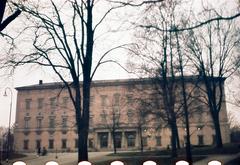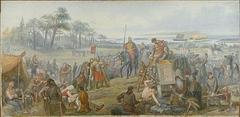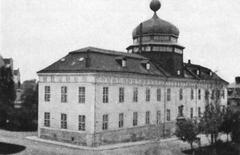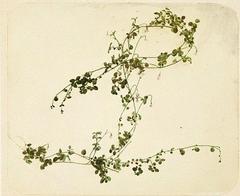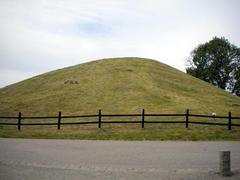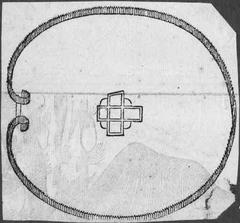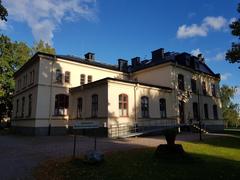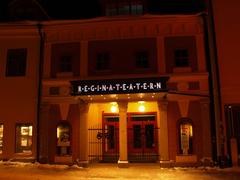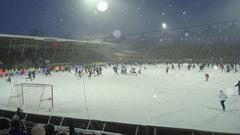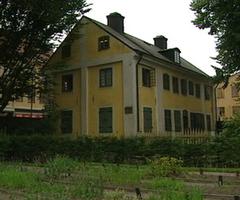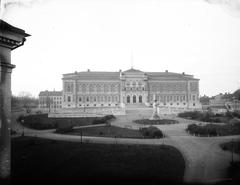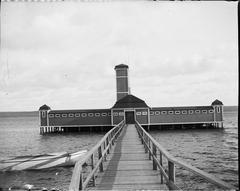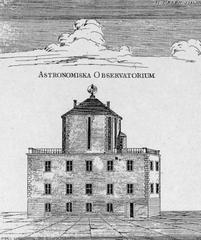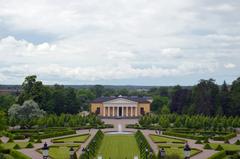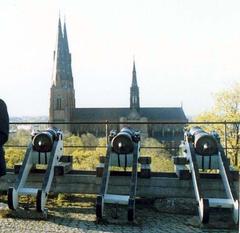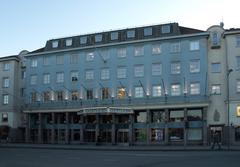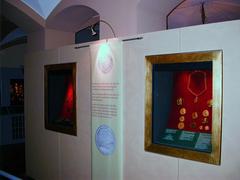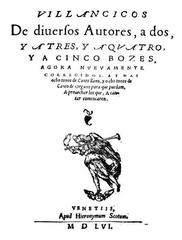Gamla Uppsala Museum Visiting Hours, Tickets, and Travel Guide
Date: 14/06/2025
Introduction to Gamla Uppsala Museum and Its Significance
Gamla Uppsala Museum, situated just north of Uppsala in Sweden, is a key destination for anyone interested in Viking and Iron Age history. The museum stands amid one of Sweden’s most celebrated archaeological landscapes, dominated by the monumental Royal Burial Mounds from the 6th century, believed to be the final resting places of early Norse chieftains or kings. This area was a central hub of religious, political, and cultural life during the Vendel Period and Viking Age, famously hosting the Asa-temple where Norse gods like Odin, Thor, and Freyr were venerated (destinationuppsala.se; viking.style).
The museum, designed by acclaimed Swedish architect Carl Nyrén, offers a modern yet harmonious architectural experience that mirrors the ancient mounds. Its exhibitions guide visitors chronologically through Gamla Uppsala’s development—from prehistoric settlements and pagan rituals to the Christianization and medieval transformation of the region (destinationuppsala.se; upplandsmuseet.se).
Inside, visitors encounter a wealth of archaeological finds, including grave goods such as weapons, jewelry, and textiles, as well as interactive multimedia and Virtual Reality (VR) experiences that reconstruct 7th-century life. The museum also runs regular guided tours, educational programs, and special events like Viking festivals, all aimed at deepening the understanding of Gamla Uppsala’s enduring cultural legacy (upplandsmuseet.se; destinationuppsala.se).
Complementing the museum, the surrounding archaeological park is freely accessible, featuring the royal burial mounds, the 12th-century Gamla Uppsala Church (built on the former pagan temple site), the Valsgärde burial fields, and the Disagården open-air museum. The site is designed for accessibility, with paved paths and facilities for visitors with disabilities. For practical details on visiting hours, tickets, and transportation, see the sections below (upplandsmuseet.se; destinationuppsala.se).
For anyone fascinated by Viking history, Norse mythology, or Sweden’s national heritage, Gamla Uppsala Museum offers an immersive journey from legend to archaeology, making it an essential stop in Uppsala (campervansweden.com; thecrazytourist.com).
Quick Contents
- Early Origins and Pre-Viking Significance
- Gamla Uppsala in the Viking Age
- Archaeological Discoveries and Burial Practices
- Religious and Mythological Importance
- Transition to Christianity and Medieval Developments
- Visiting Gamla Uppsala: Hours, Tickets, and Tips
- Guided Tours, Special Events, and Photography
- The Role of Gamla Uppsala Museum
- Museum Architecture and Setting
- Core Exhibitions and Artifact Collections
- Interactive and Immersive Experiences
- Accessibility and Facilities
- Exploring the Burial Mounds and Outdoor Areas
- Practical Tips & FAQs
- Summary and Recommendations
- Sources
Early Origins and Pre-Viking Significance
Gamla Uppsala’s history stretches back to the late Iron Age, with archaeological evidence of settlement as early as the 3rd century AD. Its status grew during the Vendel Period (c. 540–800 AD), when it became the focal point for political, religious, and cultural activities in what would become Sweden (destinationuppsala.se).
The three massive royal burial mounds, dating from the 6th century, are the site’s most prominent features. These mounds, sometimes associated with the gods Odin, Thor, and Freyr, reflect the area’s deep mythological resonance and status as a ceremonial and burial center (viking.style).
Gamla Uppsala in the Viking Age
During the Viking Age (c. 800–1050 AD), Gamla Uppsala was the foremost religious and political center for the Svear people. The Asa-temple here was renowned for its grandeur and religious significance, attracting pilgrims and dignitaries from across Scandinavia. Adam of Bremen’s 11th-century chronicles describe it as a temple of gold, central to Norse worship (destinationuppsala.se).
Gamla Uppsala was also a major venue for the Thing, the Viking assembly where laws were made and disputes settled, underscoring its importance in the early development of Swedish society (viking.style).
Archaeological Discoveries and Burial Practices
Excavations have revealed cremation burials within the royal mounds, accompanied by grave goods such as weapons, jewelry, and imported luxury items, signifying the high status of those interred (destinationuppsala.se). The nearby Valsgärde burial fields are notable for their ship burials, containing boats with warriors’ remains and grave goods, highlighting the martial culture and extensive trade networks of the era.
Runestones scattered around Gamla Uppsala commemorate individuals and events, providing insights into the language and beliefs of the time.
Religious and Mythological Importance
The Asa-temple at Gamla Uppsala was the heart of Norse pagan worship in Sweden. Major festivals—like the midwinter blót—were conducted here, involving rituals to secure the gods’ favor. The mounds’ association with legendary gods and rulers has enshrined Gamla Uppsala in Swedish myth and cultural identity (viking.style).
Transition to Christianity and the Medieval Era
The 11th and 12th centuries saw Gamla Uppsala transformed as Christianity supplanted pagan traditions. The 12th-century Gamla Uppsala Church was built atop the former pagan temple, symbolizing this shift (all-things-nordic.com). Political and religious life gradually moved to the new city of Uppsala, but Gamla Uppsala remained a site of pilgrimage and memory.
Visiting Gamla Uppsala: Hours, Tickets, and Tips
Opening Hours
- Summer Season (June–August): Daily, 10:00–17:00
- Off-Season: Hours may vary; check the official website for current times.
Tickets
- Adults: ~100–150 SEK
- Seniors/Students: Discounted rates
- Children/Youth: Free up to 18–19 years (varies by season)
- Annual Pass: Available for museum and Upplands Museum combined
- Outdoor Area: Free access
Tickets can be purchased at the museum or online (upplandsmuseet.se).
Access & Facilities
- Wheelchair Accessible: Museum and paths
- Parking: Available; includes camper spots
- Public Transport: Bus lines 2 or 210 from Uppsala city center
- Café & Gift Shop: Onsite
- Restrooms & Baby Changing Facilities: Available
Museum Architecture and Setting
The museum’s dome-shaped building, designed by Carl Nyrén, visually echoes the adjacent burial mounds. Large panoramic windows offer sweeping views of the archaeological landscape, creating a seamless dialogue between past and present.
Core Exhibitions and Artifact Collections
Permanent exhibitions focus on the Vendel and Viking Ages, chronicling Gamla Uppsala’s role as a political and religious hub and tracing the transformation from paganism to Christianity. Highlights include:
- Artifacts from the Royal Burial Mounds: Charred beads, melted buckles, jewelry, weaponry, and everyday items.
- Interactive Digital Displays: Multimedia reconstructions of ancient rituals, landscapes, and daily life.
- Runestones and Epigraphy: Temporary exhibitions explore runic inscriptions and their cultural contexts.
Interactive and Immersive Experiences
The museum features VR experiences and interactive multimedia, allowing visitors to digitally explore 7th-century Gamla Uppsala. These immersive tools make history accessible for all ages.
Guided Tours and Educational Programs
Guided tours in Swedish and English are available, included in the ticket price during peak season, and cover both museum exhibits and the burial mounds. Private group tours and educational workshops for schools and families can be booked in advance. The museum also offers lectures and theme days throughout the year.
Exploring the Burial Mounds and Outdoor Areas
A network of paved paths lets visitors explore the three monumental mounds and the wider archaeological park. Interpretive signs provide context, and the elevated vantage points offer excellent views and photo opportunities. The nearby Disagården open-air museum features historic farm buildings and hosts traditional festivals such as Midsummer.
Practical Tips for Visitors
- Best Time: Late spring to early autumn for pleasant weather and special events.
- Visit Duration: 2–3 hours recommended for museum and mounds.
- Photography: Permitted in most areas; refrain from flash near sensitive exhibits.
- Language: Exhibits in Swedish and English; check for English guided tour times.
- Respect: Treat burial mounds as sacred historical graves.
Frequently Asked Questions (FAQs)
Q: What are the Gamla Uppsala Museum opening hours?
A: Generally daily, 10:00–17:00 in summer; check upplandsmuseet.se for seasonal changes.
Q: How much are tickets?
A: 100–150 SEK for adults, with discounts for seniors, students, and free entry for children/youth.
Q: Is the museum wheelchair accessible?
A: Yes, both the museum and outdoor paths are accessible.
Q: Are guided tours available in English?
A: Yes, regularly during summer and by arrangement at other times.
Q: Can I visit other historical sites nearby?
A: Yes, including Uppsala Cathedral, Gustavianum Museum, and Disagården open-air museum.
Q: Where can I buy tickets?
A: Onsite at the museum or online at upplandsmuseet.se.
Summary and Visitor Recommendations
Gamla Uppsala Museum, set within an unparalleled ancient landscape, offers a captivating journey through Sweden’s past. The thoughtfully curated exhibitions, combined with interactive technology and expert-guided tours, illuminate the intertwining of myth, religion, and politics that shaped early Scandinavian society. The outdoor park, featuring the iconic Royal Mounds and 12th-century church, provides a powerful connection to history. Excellent accessibility, family-friendly amenities, and a lively calendar of events and festivals make Gamla Uppsala welcoming for all.
For the best experience, check updated hours and ticket options online, plan to join a guided tour, and download the Audiala app for interactive audio guides. Don’t miss nearby attractions like the Valsgärde burial fields and Gustavianum Museum for an even deeper dive into Uppsala’s heritage.
Sources and Further Reading
- Gamla Uppsala Visiting Hours, Tickets, and Historical Guide to Uppsala’s Viking Heritage (destinationuppsala.se)
- Gamla Uppsala Museum Visiting Hours, Tickets & Historical Highlights in Uppsala (upplandsmuseet.se)
- Gamla Uppsala Museum: Visiting Hours, Tickets, and Cultural Significance of Uppsala Historical Sites (destinationuppsala.se)
- Gamla Uppsala Museum Visiting Hours, Tickets & Historical Insights (upplandsmuseet.se)
- Campervan Sweden Blog: Uppsala Viking Information (campervansweden.com)
- Viking Style: What was Uppsala to the Vikings? (viking.style)
- The Crazy Tourist: 15 Best Things to Do in Uppsala, Sweden (thecrazytourist.com)
- All Things Nordic: City of the Month – Uppsala (all-things-nordic.com)
